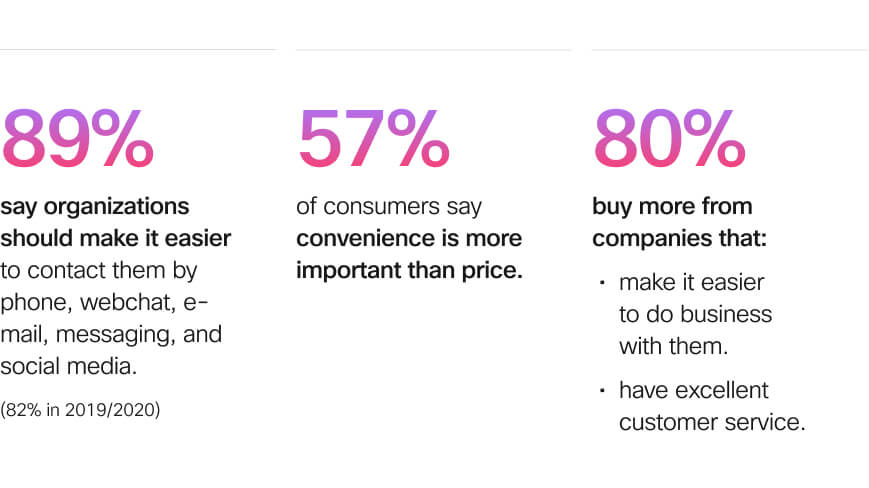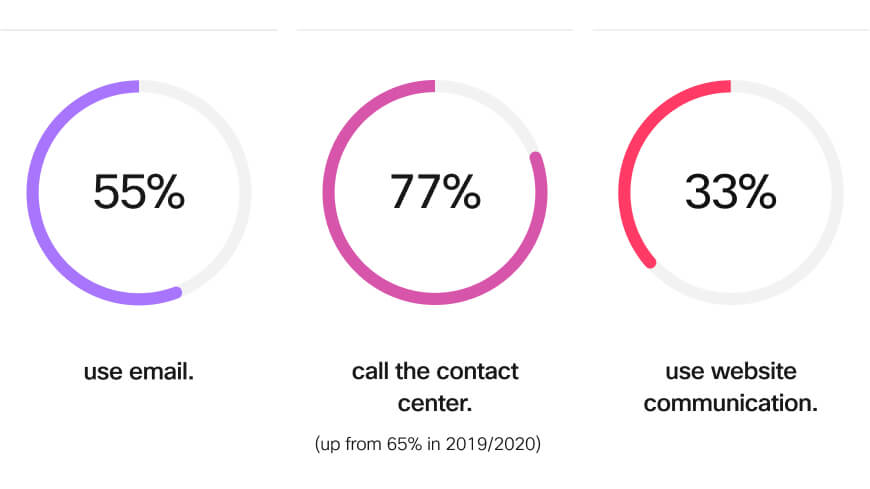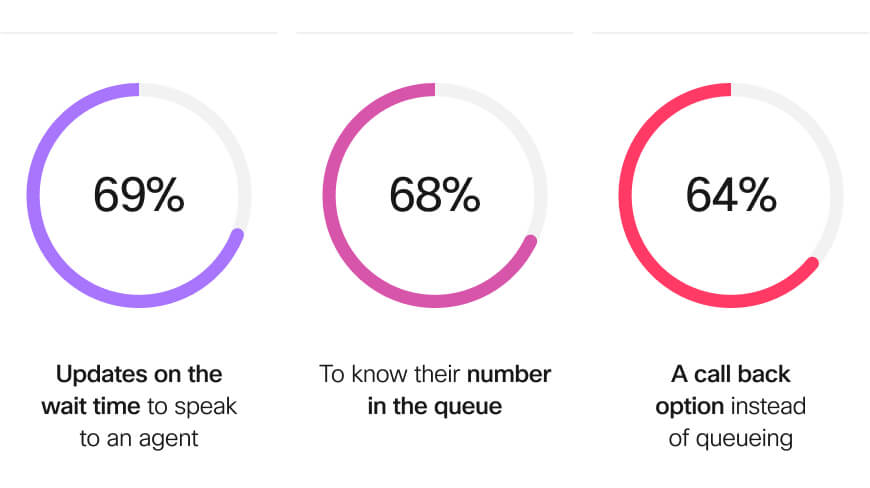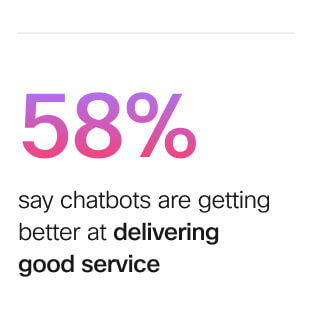The autonomous customer - 10 trends to consider when designing omnichannel customer journeys.
Discover the latest trends affecting customer experience from BT’s Principal Innovation Partner.

Contents
At a recent event we heard from Dr Nicola Millard, Principal Innovation Partner, BT. Dr Millard presented recent research into consumer attitudes and usage patterns from a survey by BT and Cisco called The Autonomous Customer—Protecting the human experience in a digital world.
In her talk, Dr Millard explored how customer experience (CX) expectations have changed since the pandemic by comparing 2023 statistics with combined findings from 2019/2020.
But what does the research mean for brands today, and how should organizations adjust the way they interact with their customers? In this blog, we’ll be looking at 10 trends from the report that are important for all organizations to consider when designing omnichannel customer journeys.
Get all the research highlights with this handy free infographic.
1. Customers still want simpler interactions with brands
The pandemic did little to reset customer expectations, with many attitudes remaining roughly the same compared to survey results from 2019/2020.
Most consumers still find it tiring to deal with organizations around customer service issues, and they say it’s time-consuming to speak with an advisor. Around nine out of ten consumers say organizations should make it easier to contact them by phone or digital channels.
2. Making things easier wins more business

Four out of five consumers will buy more from companies that make it easier to do business with them and those that provide excellent customer service—a slight increase from the 2019/2020 surveys.
More than half (57%) say convenience is more important than price (almost the same as three years ago). And two out of three say they should be able to switch from webchat to a voice or video call with the same agent.
3. Consumers still favor traditional channels
Despite the rapid shift to digital channels in 2019/2020, the telephone is still the preferred channel (by 77% of people), especially when things go wrong in the digital space. In fact, the biggest change in the research results, apart from a drop in in-store visits, has been an increase in telephone interactions.

Contact across other channels, meanwhile, has stayed largely static since 2019/2020, with a minimal shift in omnichannel usage.
Multiple, synchronous conversations with agents across different channels (chat and messaging) have caused frustrations. Creating more channels isn’t always the answer; the more organizations add, the more strategic they need to be about managing and integrating them to serve the customer.
4. Context drives omnichannel behaviors
When focusing on channels, it’s important for organizations to understand that consumers’ channel choice is driven by the task they want to complete, their emotional state at the time, and the level of support they think they’ll need.
Making lifestyle purchases: Consumers are in a positive mindset, and their most common channel choices are online, webchat, face-to-face, and in store.
Completing a routine transaction: People prefer to use an app or online self-service channel which makes things easier.
When in a crisis: With a negative mindset people tend to choose phone or face-to-face channels above others as they want immediate access to well-trained employees.
These consumer perceptions of channel choices have remained fixed since the start of this survey in 2013.
5. Digital fraud worsens the customer support challenge
The growing sophistication of fraud attacks means many people struggle to spot advanced scams—and consumers say the current fraud-reporting processes of organizations don’t match expectations.

More than two out of five consumers reported they’ve experienced some type of fraud scare or event
69% find it hard to tell a genuine text message from a fraudulent one.
61% say it’s “quite difficult” or “extremely difficult” to contact an organization to resolve a fraud issue.
80% say organizations should prioritize customers reporting fraud.
6. Don’t forget the customer behind the customer
How are you making it easier for shadow customers (those who rely on others to help them engage in the digital space on their behalf) to engage with your organization as part of the digital CX journey?
In the UK, 16 million people help others to contact organizations for various tasks and around 25 million help other people make purchases online.
This involves complex issues around identification to prevent fraud, from passwords and permissions to Legal Power of Attorneys. But for organizations that find new solutions to ease the process for these consumers, it presents an opportunity to build relationships and customer loyalty.
7. Your call is important to us—or is it?
Consumers don’t like to be kept waiting on the phone, and adding in-queue messages doesn’t ease everyone’s pain. Instead, they want:

More than two out of five consumers don’t believe standard messages that say an organization is facing high call volumes, that the customer’s call is important to the company, or that visiting a website or app can answer their query.
Around two out of three want in-queue updates on the wait time, updates on what number they are in the queue, and a callback option instead of queueing.
To win trust, organizations need to carefully consider the recorded messages they use and become smarter about how they shift customers to digital channels.
8. AI gets a warm welcome
Consumers welcome AI for its ability to improve their experience and save time by reducing the effort needed to contact an organization, supporting the agent experience, and resolving issues.
Consumers like the idea of organizations using AI to:
Identify them by their voice (59%)
Provide an immediate answer through text-based AI (71%)
Analyze call recordings to improve customer service (76%)
But organizations must exercise caution as, without the right data, generative AI can make mistakes by repeating incorrect or incomplete information.
9. A mixed reaction to chatbots
Three in four people say the benefit of chatbots is getting an immediate response, and that they help webchat advisors process simple queries. But a similar amount say chatbots often provide generic information, suggest solutions that they’ve already tried, or just can’t answer the question.

70% of people agree that bad chatbots damage an organization’s brand reputation.
58% say chatbots are getting better at delivering good service.
79% want real human agents to check their more complicated responses.
It’s important to remember that when chatbots fail—say, by relying on data in siloed legacy systems—there can be negative consequences.
Chatbots need to be integrated into the contact center where they can send information to the correct agent. With the proper context, the agent can reduce the customer’s effort. With the right supporting system—like a single, centralized Communications Platform-as-a-Service solution—the organization can make the entire journey seamless, enhancing the CX.
10. An increase in video chat opens the door to the Metaverse
The number of consumers that would use video chat across an organization’s website or app has risen across the board since 2019/2020, meaning organizations can add value by offering this channel.
Consumers are most excited about using video chat to demonstrate the issue with a product, fix technology, or learn how to use it. This opens the door to the Metaverse, with consumers more accepting of its incorporation into customer service for the same scenarios—at least in theory.
Consumers are open to change—but remain cautious
Much of the research paints a clear picture that customer challenges—and their preferred channels—remain relatively static. But there’s a clear appetite for new service capabilities like AI and video chat.
The challenge for organizations is to find smart ways to integrate these into their customer journeys in a way that augments service experiences and communications, without asking more effort from the customer. That requires a technological and strategic shift to a connected, integrated mode of customer communications.
To dive deeper into the research, download the report: The Autonomous Customer: Being Human in a Digital World or watch the full presentation.
